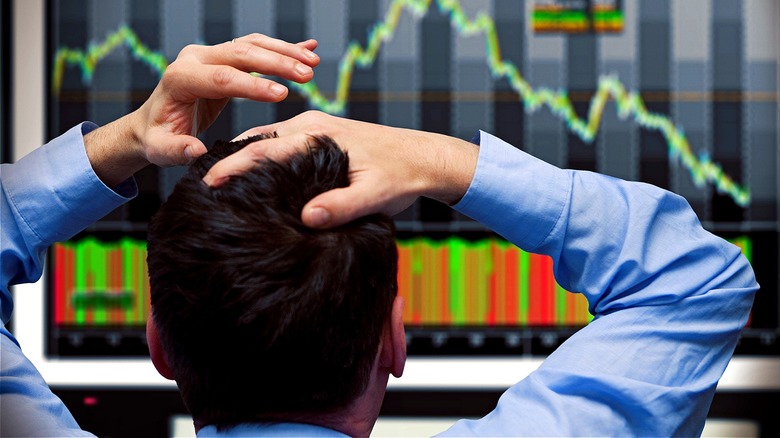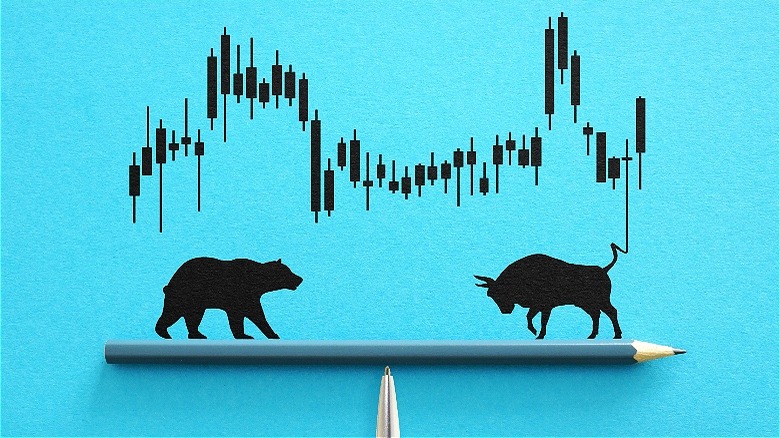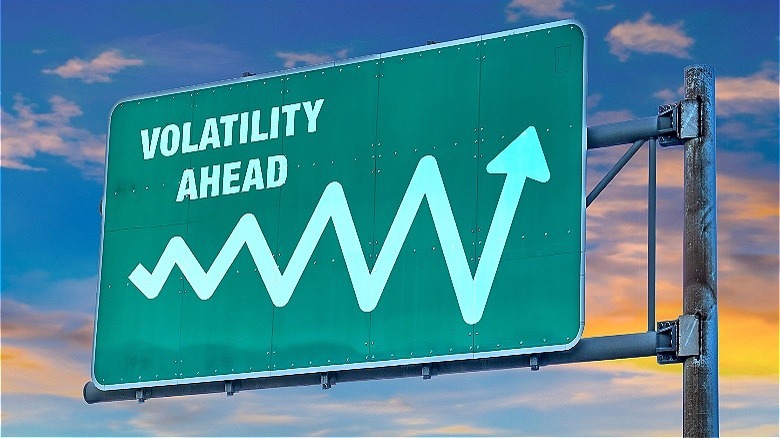What Is Wall Street's 'Fear Gauge' And Why Is It Spiking?
On August 5, 2024, U.S. stocks tumbled to begin the week, building on a selling trend that had started the week prior. Blame for the steep decline in stock prices was assigned to the possibility of an upcoming recession, weakness in Japan's stock market, and whether investments in artificial intelligence technology will be as valuable to businesses as originally thought.
As of mid-morning, the benchmark S&P 500 index was down approximately 3%. However, that move was a proverbial drop in the bucket compared to the reaction of the CBOE Volatility Index (VIX), which at one point jumped 42 points from a previous closing of 23.39 to an intraday high of 65.73. To put it another way, the VIX's 170% surge from Friday to today represents the index's largest one-day gain of all time.
But what exactly is this mysterious VIX index? Per the CBOE itself, VIX is "the first benchmark index to measure the market's expectation of future volatility. The VIX Index is based on options of the S&P 500 Index, considered the leading indicator of the broad U.S. stock market." The index is also commonly known as Wall Street's "fear gauge" (or "fear index").
The stock market has been calm for a while
For the past few years following the COVID-19 pandemic, stock market volatility has been quite tame without any massive spikes. Although the broader stock market experienced a few corrections, it also quickly recovered. Many investors grew largely complacent with a belief that the stocks will continue to rise, unabated. The S&P 500 index recently concluded a spree of 356 trading sessions — that's more than 70 weeks — without experiencing a loss of 2% or greater. That's something which hadn't been seen since the housing-bubble days of 2007; but some cracks are finally beginning to show.
Now, all of a sudden, investors are staring down a 3% daily drop in the S&P 500 index. And that's compounding off some already sharp losses from last Friday. Plain and simple, market sentiment is turning more negative and investors are growing more fearful. In fact, some younger investors might never have experienced a sustained downturn or bear market. Recent sell-offs, relatively mild though they may be, have instilled a sense of mortality in brash investors and increased market volatility. That's reflected in an escalated VIX index, a de facto "fear gauge" that spent the majority of 2024 thus far hovering around a 13 level.
For context, a VIX level of zero to 12 indicates low market volatility, while one between 13 and 19 would be normal. Once the volatility index goes above 20, however, that's when investors can expect to see greater volatility in the market over the next 30 days.
You can profit from market volatility, or a lack thereof
Even after this morning's brutal market action, the S&P 500 index is still up approximately 10% year-to-date. Compare that to the infamous Black Monday in October 1987 when the S&P 500 shed ~20% of its value in a single day. The VIX wasn't created until 1993, but if it existed on that fateful day in 1987, we're sure there would've been fireworks as well. That said, sharp spikes in the VIX tend to be fairly short-lived, as relative calm returns to market participants.
Still, today's VIX surge is likely an indicator the market isn't immediately returning to a sustained range of 12 to 14, either. However, if the Federal Reserve cuts interest rates at its next meeting this September, that could go a long way toward calming fears of an economic downturn and lowering the volatility index.
If you want to attempt to profit from stock market fear and volatility, as measured by the "fear gauge," note that you can't buy shares of the VIX index directly. However, there are a multitude of exchange-traded funds (i.e., ETFs) that mirror the performance of the benchmark volatility index. Those ETFs can be purchased through virtually any online broker or retirement account portal.
Likewise, you can bet against volatility by buying ETFs that have an inverse relationship with the underlying VIX index. In other words, you'd profit if the volatility falls. For the truly investing brave, leveraged ETFs also exist for the VIX. That means that each movement in the underlying index is magnified by double or triple. Talk about fear.


